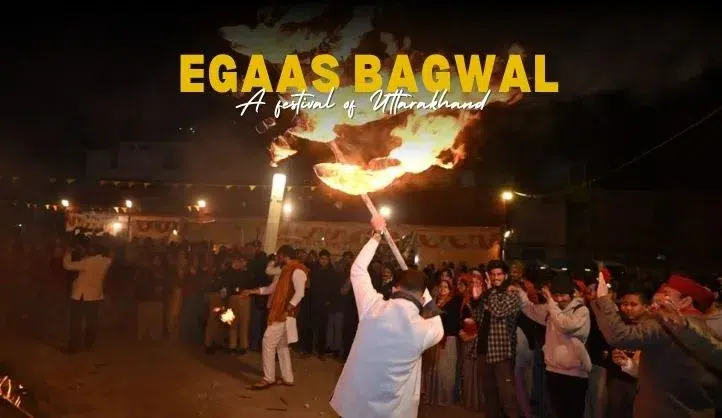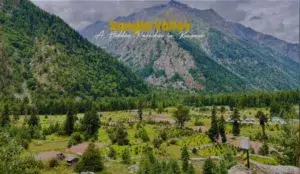While much of India settles into winter after Diwali, the Himalayan villages of Uttarakhand are just beginning their true celebration. Egaas, also known as Igas Bagwal or Budhi Diwali, is a vibrant festival observed in the Garhwal and Kumaon regions, radiating the warmth of local heritage, warrior pride, and ancestral gratitude. Celebrated eleven days after Diwali, Egaas is not just a belated celebration—it’s a cultural reaffirmation that blends mythological reverence with historical valor. From rhythmic folk dances to fire-lit rituals and hearty mountain feasts, Egaas transforms quiet valleys into glowing arenas of joy, storytelling, and spiritual connection.
What is Egaas?
Celebrated eleven days after Diwali, Egaas marks a unique cultural observance in the Garhwal and Kumaon regions of Uttarakhand. While the rest of India wraps up its Diwali festivities, the hills come alive once more with songs, dances, and fire-lit rituals that honor both mythological and historical legacies.
Origins and Legends
At the heart of Egaas lies a beloved myth deeply intertwined with the epic of the Ramayana—a tale that bridges spiritual devotion with Himalayan remoteness.
The Ramayana Connection – The Primary Origin
According to the most widely cherished belief across Garhwal and Kumaon, the people of Uttarakhand received news of Lord Rama’s triumphant return to Ayodhya much later than the rest of India. Due to the slow transmission of messages through rugged terrains and isolated valleys, the word of Diwali’s significance reached them eleven days after the actual celebration.
- In response, villagers lit diyas, sang bhajans, and rejoiced in their own heartfelt version of Diwali.
- This delayed yet deeply spiritual celebration became known as Egaas—a glowing tribute to their unwavering faith and connection to divine tradition.
- The term “Budhi Diwali” or “Old Diwali” reflects not just timing, but the enduring spirit of a community that celebrated when they could, not when they were told.
This origin not only underscores Uttarakhand’s reverence for Lord Rama but also reflects the resilience and autonomy of its hill societies—living harmoniously with nature, time, and spiritual legacy.
Folk Valor and the Story of Veer Madho Singh Bhandari
While the Ramayana tale is central, another historical legend enhances Egaas with a spirit of valor. Veer Madho Singh Bhandari, a 17th-century commander, led Garhwali forces to victory against Tibetan invaders. Upon returning home eleven days after Diwali, his arrival sparked spontaneous celebrations—blending martial pride with festive rituals.
Though secondary in origin, this tale adds a unique dimension of regional heroism, often remembered through folk songs and communal storytelling during Egaas.
Echoes from Other Traditions
Local folklore also brings in Pandava stories from the Mahabharata, Bhima’s demon-slaying adventures, and anecdotes of villagers returning from forest hunts with materials for Bhailo—each enriching Egaas with layers of narrative, memory, and mythic charm.
Bhailo – The Fiery Heart of Egaas
If Egaas is the soul of Uttarakhand’s festive spirit, then Bhailo is its blazing heartbeat—an electrifying ritual that turns quiet Himalayan nights into glowing spectacles of unity, joy, and ancestral pride.
What is Bhailo?
Bhailo refers to a traditional fire-play ritual where villagers swing flaming torches made from cheed (pine), bhimal, or hisar wood, tied with bark ropes. These torches are lit and spun in wide arcs, creating mesmerizing trails of fire against the night sky. The ritual is performed in open fields or village courtyards, often accompanied by folk songs, dances, and humorous skits.
- The torches are crafted with care, often by elders or youth who gather bark and wood days in advance.
- Before lighting, the Bhailo is ritually anointed—sometimes with ghee or oil—and blessed as a symbol of light driving away darkness.
Songs and Dances That Set the Night Ablaze
Bhailo is never performed in silence. It’s accompanied by traditional Garhwali and Kumaoni songs like:
- “Bhailo Re Bhailo” – a rhythmic chant that energizes the crowd.
- “Ujaylu Aalo Andhero Bhagalu” – meaning “Let light shine and darkness flee.”
- “Kakhdi Ko Railu” – a playful folk tune often sung during the dance.
These are paired with Chanchhari and Jhummelon dances, where villagers form circles, sway to the beat of dhol and damau, and celebrate with infectious enthusiasm. The dances are inclusive—children, elders, and visitors all join in, making Bhailo a true community affair.
Symbolism and Cultural Significance
Bhailo isn’t just a performance—it’s a symbolic act of purification, celebration, and remembrance:
- The fire represents victory over evil, echoing the Ramayana’s themes and the valor of local heroes like Madho Singh Bhandari.
- The circular motion of the flames is believed to ward off negative energies and bring prosperity for the coming winter.
- In some villages, Bhailo is also used to honor ancestors, with songs that recount local legends and heroic deeds.
Rituals Around Bhailo Night
On Bhailo night, homes are lit with diyas, cattle are bathed and decorated with garlands, and special meals are prepared. Villagers gather in their finest traditional attire, and the evening often includes:
- Pāndav Nṛitya performances dramatizing epic tales.
- Haasya-vyang (humorous skits) that poke fun at village life and politics.
- Community feasts featuring dishes like urad dal pakoras, mandua roti, and jhangora kheer.
Festive Flavors and Rituals
Egaas is also a culinary celebration. Families prepare traditional dishes like puri, swala, and pakoras, and offer special meals to cattle, adorning them with garlands and oiling their horns, a gesture of gratitude and reverence.
Homes are cleaned and lit with diyas, echoing the spirit of Diwali but with a distinctly local flavor. In some villages, Pāndav Nṛitya performances and humorous skits add to the festive charm.
Other Vibrant Festivals of Uttarakhand
Uttarakhand’s cultural calendar is a tapestry of seasonal celebrations, spiritual observances, and community fairs. Beyond Egaas, here are a few standout festivals that reflect the region’s rich heritage:
Phool Dei – The Blossom of Spring
Celebrated on the first day of Chaitra (March–April), Phool Dei is a harvest and spring festival where young girls go door to door, placing flowers, rice, and jaggery on thresholds to bless homes with prosperity. The ritual is accompanied by folk songs and the sharing of a sweet pudding called dei, made from curd, flour, and jaggery.
Harela – A Green Prayer for Abundance
Observed in July to mark the onset of the monsoon, Harela is a Kumaoni agricultural festival symbolizing fertility and renewal. Families sow seeds in small baskets days before the festival, and the sprouted greens—called harela—are placed behind ears as blessings. It also commemorates the wedding of Lord Shiva and Parvati.
Kumaoni Holi – A Musical Riot of Colors
Unlike the boisterous Holi of the plains, Kumaoni Holi is a musical celebration that begins weeks in advance. It includes three styles—Baithki Holi (classical ragas sung in gatherings), Khari Holi (processional singing in traditional attire), and Mahila Holi (women-led musical sessions). The festival blends color with melody, making it uniquely soulful.
Ghee Sankranti – A Tribute to the Land and Ancestors
Celebrated in August, Ghee Sankranti (also called Olgia) is a festival of gratitude where farmers and artisans offer gifts to landlords and elders. Traditional dishes made with ghee and grains are shared, and rituals honor the ancestral spirits and agricultural bounty.
Why Egaas Matters Today
In recent years, efforts have been made to revive and preserve Egaas, recognizing its role in sustaining Uttarakhand’s cultural identity. It’s more than a festival, it is a symbol of community pride, ecological consciousness, and intergenerational storytelling.
For travelers and culture enthusiasts, Egaas offers a rare glimpse into the soul of the Himalayas, where history dances with firelight and tradition sings through the valleys.
FAQs About Egaas Festival of Uttarakhand
1. What traditional attire is worn during Egaas celebrations?
During Egaas, locals often wear regional costumes like ghagra-choli for women and kurta-pajama with woolen caps for men. In some villages, handwoven woolen shawls and jewelry made from brass or silver are worn to honor ancestral customs.
2. Are there any specific mantras or chants associated with Egaas?
Yes! In addition to folk songs, some communities recite local mantras and invocations to deities like Bhumi Devi and Gram Devta before lighting Bhailo. These chants are believed to purify the space and invite blessings for the winter season.
3. Is Egaas recognized in school curricula or cultural programs?
In recent years, state-run schools and cultural academies have begun incorporating Egaas into heritage education modules, including folk song competitions, Bhailo-making workshops, and storytelling sessions to preserve oral traditions.
4. Are there trekking destinations that align with Egaas celebrations?
Yes! Villages near Chakrata, Pauri, and Rudraprayag often host Egaas-themed events. Trekkers visiting during this time can witness Bhailo performances in open meadows, making it a unique blend of adventure and culture.
5. What are some rare or symbolic dishes prepared during Egaas?
Apart from common fare, some villages prepare “mithhe karele” (sweet bitter gourd) and “lal basmati rice”, which symbolize bittersweet memories and ancestral blessings. These dishes are often cooked in earthen pots to retain traditional flavor.
6. Are animals other than cattle honored during Egaas?
Yes! In certain agrarian villages, goats and sheep are also decorated and fed special meals. This practice reflects the broader reverence for livestock that sustain mountain life.
7. Is there any connection between Egaas and bird migration?
Interestingly, some elders associate Egaas with the arrival of migratory birds like Himalayan monals and pheasants, viewing them as omens of seasonal change and prosperity.





